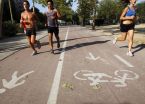(Press-News.org) Bethesda, MD (Oct. 2, 2014) — Nonsteroidal anti-inflammatory drugs (NSAIDs) — such as ibuprofen and aspirin — increase one's risk of upper gastrointestinal bleeding. When taken in combination with other drugs, this risk is significantly higher, according to new research appearing in the October issue of Gastroenterology, the official journal of the American Gastroenterological Association.
"These findings may help clinicians tailor therapy to minimize upper gastrointestinal bleeding, and are especially valuable in elderly patients who are likely to use multiple drugs at the same time," said Gwen Masclee, MD, lead study author from Erasmus Medical Center in Rotterdam, the Netherlands. "Defining risk factors is a critical step towards improving care and decreasing NSAID-associated complications and deaths."
Researchers performed a self-controlled case series analysis of data from 114,835 patients with upper GI bleeding. Drug exposure was determined based on prescriptions of NSAIDs, cyclooxygenase 2 (COX-2) inhibitors — such as Bextra®, Celebrex® and Vioxx® — or low-dose aspirin, alone and in combination with other drugs that affect risk for internal bleeding. This study identified that:
Single therapy with non-selective NSAIDs (the commonly found NSAIDs, which contain both COX-1 and COX-2 enzymes) is more likely to cause upper GI bleeding than single therapy with COX-2 inhibitors or low-dose aspirin.
Combination therapy significantly increases the risk for internal bleeding, with simultaneous use of non-selective NSAIDs and steroid therapies increasing the risk to the greatest extent.
The risk of upper GI bleeding is always higher for drug combinations with non-selective NSAIDs than that for low-dose aspirin or COX-2 inhibitors.
Simultaneous use of non-selective NSAIDs or low-dose aspirin, but not COX-2 inhibitors, with corticosteroids, aldosterone antagonists (diuretic drugs) or anticoagulants (which prevent the blood from clotting) produces significant excess risk of upper GI bleeding.
In patients with increased risk, the researchers recommend first reassessing the need for NSAID therapy (or for the concomitant medication). If feasible, discontinuation of NSAIDs is the preferred strategy in high-risk patients. When NSAIDs are necessary, they should be used at the lowest effective dose for the shortest possible duration.
"Importantly, we found that risk varies dramatically from patient to patient based on underlying characteristics, necessitating careful review to assess risk in each individual using NSAIDs," added Dr. Masclee.
NSAIDs act as pain relievers and fever reducers. Prescription NSAIDs can also work to reduce inflammation. There are currently more than 500 over-the-counter and prescription NSAIDs, including ibuprofen (Advil®, Motrin IB®), naproxen sodium (Aleve®) and aspirin (Bayer®).
INFORMATION:
Patients should always disclose all of their medications to their physician and work together to determine a safe plan for medication use. The American Gastroenterological Association has created the Gut Check: Know Your Medicine educational campaign to motivate and empower individuals to engage in the safe use of medication and prevent unnecessary deaths from GI bleeding. To learn more about this campaign, explore gutcheckfacts.org.
1Masclee, et al. Risk of Upper Gastrointestinal Bleeding From Different Drug Combinations. Gastroenterology 2014: 147(4): 784-792.e9
About the AGA Institute
The American Gastroenterological Association is the trusted voice of the GI community. Founded in 1897, the AGA has grown to include 17,000 members from around the globe who are involved in all aspects of the science, practice and advancement of gastroenterology. The AGA Institute administers the practice, research and educational programs of the organization. http://www.gastro.org.
About Gastroenterology
Gastroenterology, the official journal of the AGA Institute, is the most prominent scientific journal in the specialty and is in the top 1 percent of indexed medical journals internationally. The journal publishes clinical and basic science studies of all aspects of the digestive system, including the liver and pancreas, as well as nutrition. The journal is abstracted and indexed in Biological Abstracts, Current Awareness in Biological Sciences, Chemical Abstracts, Current Contents, Excerpta Medica, Index Medicus, Nutrition Abstracts and Science Citation Index. For more information, visit http://www.gastrojournal.org.
Like AGA and Gastroenterology on Facebook.
Join AGA on LinkedIn.
Follow us on Twitter @AmerGastroAssn.
Check out our videos on YouTube.
The bond between humans and dogs is strong and ancient. From being the protector of the first herds in a faithful pet, dogs and people share many aspects of life. The relationship between the two species has been studied by psychologists, anthropologists, ethnologists and also by genetic and molecular biologists. In this sense, dogs are a great model for understanding the causes of human diseases, especially cancer.
Unlike other mammals used in research, dogs develop cancer spontaneously as humans do and cancer is the most common cause of death in this species. The dog ...
This news release is available in French, Spanish and German.
Low digital skills and competences among school pupils and the need to integrate effective use of information and communication technologies into teacher training are among the most pressing challenges faced by European school education today, according to a report published by the European Commission and the New Media Consortium, a US-based not-for-profit body bringing together experts in education technology. The first-ever Horizon Report Europe: 2014 Schools edition outlines the trends and technological ...
A study analysing the positive and negative effects of energy drinks on athletes has seen that, although in principle their sports performance was seen to improve by between 3% and 7%, there was also an increase in the frequency of insomnia, nervousness and the level of stimulation in the hours following competition.
The consumption of energy drinks has increased in recent years. In the case of athletes, the use of them before practising sport has also risen: more than 50% take them during training and even before competitions.
A four-year study carried out by experts ...
This news release is available in Spanish. According to a recent paper published by the researchers Aritz Urdampilleta-Otegui, PhD in Physical Education and Sports and lecturer in the Department of Physical and Sports Education of the UPV/EHU-University of the Basque Country and at the Government of the Basque Autonomous Community (region), and Saioa Gómez-Zorita, PhD in Pharmacy and Food Sciences and researcher at the UPV/EHU's Department of Pharmacy and Food Sciences, it is necessary to control the administering of drugs that interact with the foods consumed and which ...
Barely perceptible low-frequency signals nevertheless activate measurable responses in our auditory circuits. Neurobiologists at Ludwig-Maximilians-Universitaet (LMU) in Munich have now characterized the remarkable impact of low-frequency sounds on the inner ear.
The human auditory system appears to be poorly adapted to the perception of low-frequency sound waves, as hearing thresholds become markedly higher for frequencies lower than about 250 Hz. Yet sensory cells do react to pressure waves with frequencies below 100 Hz, as revealed by the fact that such signals actually ...
A new test developed by researchers from the University of Manchester could revolutionise the discovery of new prescription drugs. The test will help determine which drugs are unlikely to work at an early stage, speeding up the time it takes to make safe and effective medicines available. The findings are published online in the journal Metabolomics.
The Pharmaceuticals industry is worth billions of dollars a year. The main source of prescription medicines comes from what are known as 'small molecule' drugs, such as statins and antibiotics.
The main problem for ...
AUDIO:
These are gray snapper larval growls recorded in the field.
Click here for more information.
MIAMI – A new study from researchers at the University of Miami (UM) Rosenstiel School of Marine and Atmospheric Science is the first to document that fish larvae produce sound. These "knock" and "growl" sounds may help small larvae maintain group cohesion in the dark.
"Although many adult fishes produce sounds, no one has previously considered that larvae, too, may be sound ...
For decades, research has generally focused on individual, family and peer factors to explain illicit drug use, neglecting neighborhood factors as a cause. While the scant previous research on neighborhood factors and illicit drug use has focused on facets such as crime and socio-demographic characteristics, none has explored the associations between the perceived frequency of drug sales, drug use, and peer attitudes towards drug use. Now a study out of New York University's Center for Drug Use and HIV Research (CDUHR), address this paucity in the research.
Published ...
Schizophrenia and bipolar disorder both appear to be associated with dendritic spine loss in the brain, suggesting the two distinct disorders may share common pathophysiological features, write author Glenn T. Konopaske, M.D., and colleagues at McLean Hospital, Belmont, Mass., and Harvard Medical School, Boston.
The dendritic spines play a role in a variety of brain functions. Previous studies have observed spine loss in the dorsolateral prefrontal cortices (DLPFCs) from individuals with schizophrenia (SZ). To determine whether spine pathology happens in individuals with ...
EAST LANSING, Mich. --- New research suggests dear old Mom and Dad could be the auto industry's secret weapon.
The study, co-authored by Michigan State University economist Soren Anderson, found children are 39 percent more likely to buy a particular brand of automobile if their parents bought that brand.
This surprisingly strong correlation could have implications for automakers' marketing efforts. In absence of this inherited brand loyalty, a sensible strategy might be to "invest in young consumers and harvest old consumers" – that is, lower prices on entry-level ...




